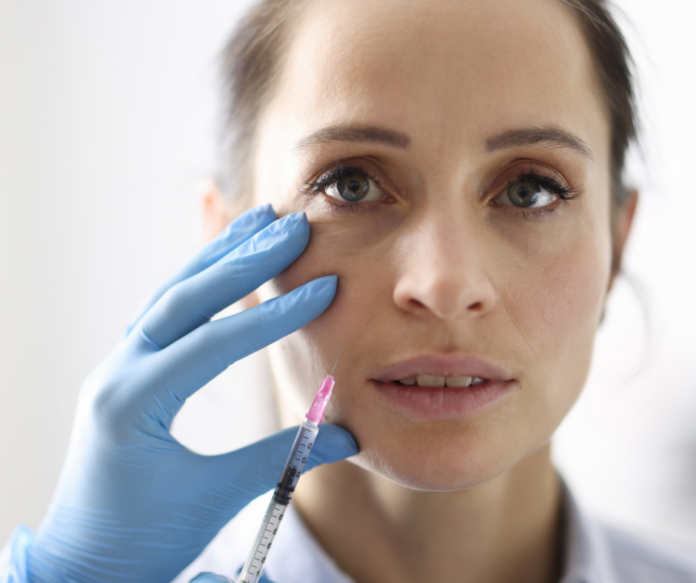
Introduction to Dermal Filler Injections and Their Risks
Dermal filler injections have become increasingly popular in recent years as a non-surgical option for individuals seeking to enhance their appearance and combat the signs of aging. These injections can help to smooth out wrinkles, plump up the skin. And restore lost volume in the face. However, as with any medical procedure, there are potential risks and complications associated with dermal filler injections. In this article, we will address the most common questions and concerns people have about the risks associated with dermal filler injections. And provide specific answers and solutions to help you make an informed decision about your medspa treatment.
What Are Dermal Fillers?
Dermal fillers are injectable substances used to fill in wrinkles, lines, and hollow areas in the face. Providing a more youthful and rejuvenated appearance. There are several types of dermal fillers available. These includes hyaluronic acid-based fillers (such as Juvederm and Restylane), calcium hydroxylapatite fillers (such as Radiesse), and poly-L-lactic acid fillers (such as Sculptra). Each type of filler has its own unique properties and is suited for different areas of the face and specific aesthetic goals.
What Are the Potential Risks and Complications of Dermal Filler Injections?
While dermal filler injections are generally considered safe and effective, there are potential risks and complications that can occur. Some of the most common risks associated with dermal filler injections include:
- Swelling and bruising: Temporary swelling and bruising at the injection site are common side effects of dermal filler injections. These side effects typically resolve within a few days to a week.
- Redness and pain: Some individuals may experience redness and pain at the injection site. Which usually subsides within a few hours to a day.
- Infection: As with any injection, there is a risk of infection. However, this risk is relatively low when the procedure is performed by a qualified and experienced practitioner in a sterile environment.
- Allergic reactions: Although rare, some individuals may have an allergic reaction to the ingredients in the dermal filler. This can result in redness, swelling, and itching at the injection site.
- Granulomas: In some cases, small lumps or nodules called granulomas may form under the skin at the injection site. These can be treated with medication or, in rare cases, may require surgical removal.
- Migration of filler: In rare cases, the filler may migrate from the injection site to other areas of the face. Causing unwanted cosmetic results.
- Vascular complications: If the filler is accidentally injected into a blood vessel, it can cause complications such as skin necrosis (tissue death) or even blindness. However, these complications are extremely rare when the procedure is performed by a skilled and experienced practitioner.
How Can I Minimize the Risks Associated with Dermal Filler Injections?
There are several steps you can take to minimize the risks associated with dermal filler injections and ensure a safe and effective treatment:
- Choose a qualified and experienced practitioner: The most important factor in minimizing the risks associated with dermal filler injections is choosing a qualified and experienced practitioner. Look for a board-certified dermatologist, plastic surgeon. Or other medical professional with extensive experience in administering dermal filler injections. You can also ask for recommendations from friends or family members who have had positive experiences with dermal filler treatments.
- Discuss your medical history and allergies: Before undergoing dermal filler injections, be sure to discuss your medical history and any allergies with your practitioner. This will help them determine if you are a good candidate for the procedure. And if there are any specific risks you should be aware of.
- Follow pre- and post-treatment instructions: Your practitioner will provide you with specific instructions to follow before and after your dermal filler injections. These may include avoiding certain medications or supplements that can increase the risk of bruising and swelling. As well as applying ice to the treatment area to minimize swelling and discomfort. Following these instructions can help reduce the risk of complications and ensure optimal results.
- Be patient with the healing process: It’s important to remember that some swelling, bruising, And redness are normal after dermal filler injections. And will typically resolve within a few days to a week. Be patient with the healing process and avoid any activities that could exacerbate these side effects. Such as strenuous exercise or exposure to extreme heat or cold.
What Should I Do If I Experience Complications After Dermal Filler Injections?
If you experience any unusual or concerning side effects after your dermal filler injections. It’s important to contact your practitioner right away. They can assess the situation and determine if any additional treatment or intervention is necessary. In some cases, complications can be managed with medication or other non-surgical treatments. While in rare cases, surgical intervention may be required.
Conclusion: Understanding the Risks and Making an Informed Decision
While dermal filler injections can provide significant aesthetic benefits and help to restore a more youthful appearance. It’s important to be aware of the potential risks and complications associated with the procedure. By choosing a qualified and experienced practitioner, discussing your medical history and allergies. Following pre- and post-treatment instructions, and being patient with the healing process. You can minimize these risks and ensure a safe and effective medspa experience. If you have any concerns or questions about dermal filler injections, be sure to consult with a medical professional to determine if this treatment is right for you.



